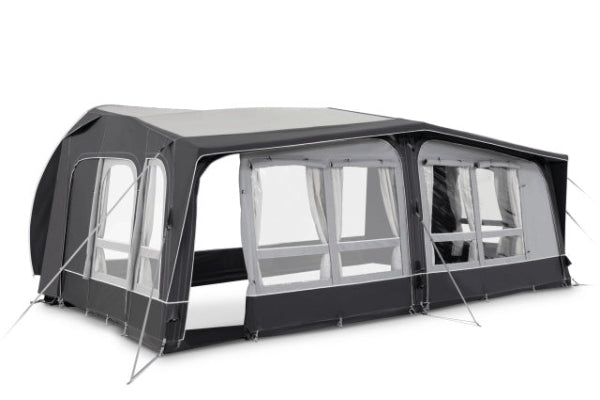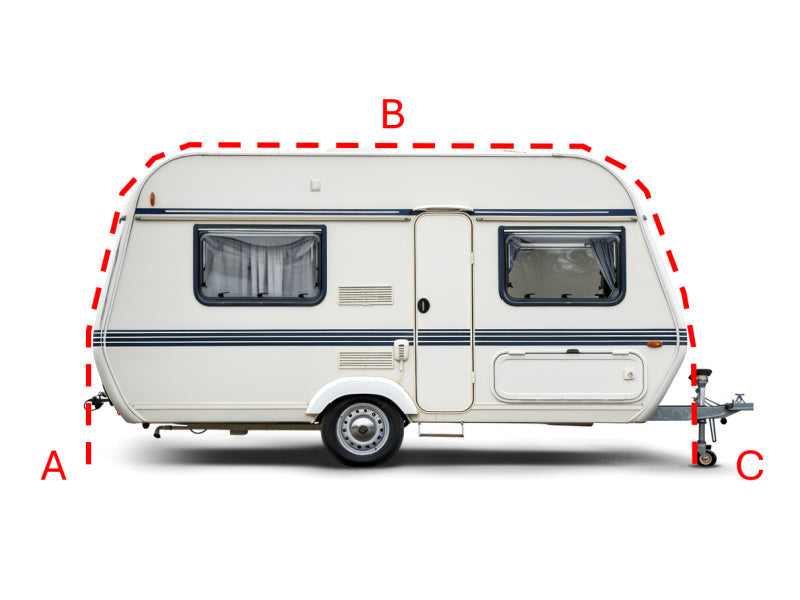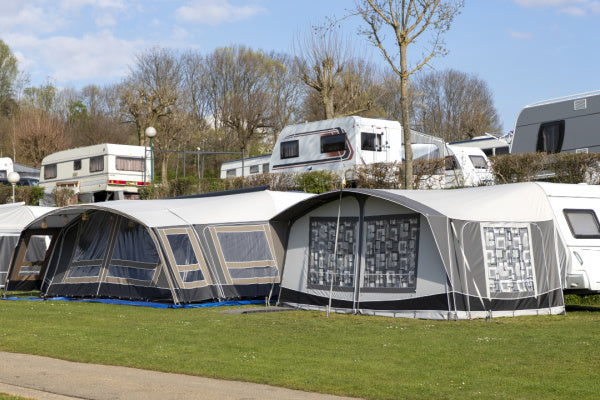Caravan Awning vs Tent
Dreaming of camping but torn between caravan awnings and tents? Here's the short answer: caravan awnings win for space and comfort, while tents triumph for flexibility and adventure. Whether you're a glamper or roughing-it enthusiast, stick around as we unpack the pros and cons of each option.

Key Differences
Attachment and Stability
Picture this: a stormy night at the campsite. While tent campers rush to check their guy ropes, caravan awning users sit back and relax. The reason? Caravan awnings connect directly to the vehicle's awning rail, creating an incredibly stable structure that works with your caravan, not against it.
The mounting system forms a robust connection that handles British weather admirably. Most modern awnings use advanced rail systems and locking mechanisms, transforming your caravan's side into a proper outdoor room.
Tents rely on more traditional stability methods - pegs, guy ropes, and pole tension. While perfectly effective when properly set up, they require more ongoing adjustment, especially during changing weather conditions.
Ease of Setup and Takedown
Gone are the days of wrestling with endless poles and complicated instructions. Modern caravan awnings, especially air models, have revolutionised the setup process.
Most awnings take about 20-30 minutes to install properly. The process typically needs two people for larger models, but the result is worth the teamwork.
Tent setup times vary dramatically based on design. Basic tents pop up in minutes, while larger models might require similar time investment to awnings. The key difference? Tents offer more forgiveness during setup - slight mistakes won't typically impact performance significantly.
Air awnings deserve special mention here. These innovative designs replace traditional poles with inflatable beams, dramatically simplifying setup. One person can often handle the entire process, though help always speeds things up.

Living Space and Comfort
This is where caravan awnings truly shine. They create legitimate outdoor rooms with proper headroom throughout the entire space. No ducking, no awkward corners, just useful space that works.
The flat, even floor (when properly levelled) transforms your outdoor area into a proper living space. Many campers use their awnings as:
- Outdoor dining rooms
- Weatherproof storage areas
- Additional bedroom space
- Entertainment zones
- Mudroom barriers between outdoors and caravan
Tents offer different space advantages. While they might not match awnings for outright living space, they provide cosy, adaptable areas that many campers prefer. Their sloping sides and varied heights create natural zones for different activities.
Weather Resistance
British weather demands serious weather protection, and both options rise to the challenge differently.
Caravan awnings typically use heavier-grade materials, often with impressive waterproof ratings. Their boxy shape means rain runs off predictably, while the caravan itself provides excellent wind protection on one side.
The best awnings use materials rated for year-round use, with UV protection and mould resistance built in. Many feature storm straps for extra stability during particularly rough weather.
Tents take a different approach. Their shapes work with the elements rather than standing firm against them. Water rolls off naturally, and wind flows around their aerodynamic designs. While the materials might be lighter, they're engineered specifically for their purpose.
Portability and Storage
Here's where tents claim a clear victory. Even larger family tents pack down into manageable bags that fit easily into car boots or storage cupboards.
Caravan awnings demand more respect when it comes to storage. Their robust materials and solid construction mean bigger, heavier packages. Storage requires planning, both at home and while travelling.
The trade-off makes sense: awnings sacrifice some portability for durability and living space. Tents prioritise mobility and flexibility.
Which is Right for You?
Camping Style and Preferences
The choice between awning and tent often comes down to camping philosophy.
Caravan awnings suit those who:
- Value comfort and space above all
- Typically stay at single sites for longer periods
- Need reliable outdoor living areas regardless of weather
- Want seamless integration with their caravan
- Appreciate having a proper outdoor room
Tents better serve those who:
- Embrace traditional camping experiences
- Move between sites frequently
- Need setup flexibility
- Prefer lighter, more portable solutions
- Want to camp anywhere, anytime

Budget and Priorities
Quality camping gear requires investment, but the price ranges differ significantly.
Caravan awnings typically cost between £500-£1500 for quality models. Premium versions with additional features can reach £2000 or more. This investment typically delivers:
- Superior durability
- Better weather resistance
- Longer lifespan
- Higher resale value
- More features and options
Tents offer more budget flexibility. Basic models start around £100, while premium family tents range from £300-£500. The lower initial cost makes tents particularly attractive for occasional campers or those testing the waters of outdoor living.
Caravan Type and Size
The perfect awning depends heavily on your caravan's specifications. Critical considerations include:
Awning Rail Height This determines which awning models will fit properly. Measure carefully - even small discrepancies can cause issues.
Storage Space Consider both travel and home storage. Some larger awnings require significant space, which might influence the decision between full or porch awnings.
Caravan Design Modern caravans often feature curved walls or special features that require specific awning types. Getting this right ensures proper fit and function.
Site Preferences Some sites have specific size restrictions or pitch types that might impact awning suitability. Research favourite destinations before making the final choice.
The verdict? Neither option claims absolute superiority. The best choice depends entirely on individual camping styles, requirements, and preferences. Both awnings and tents can provide wonderful outdoor experiences when chosen thoughtfully and used properly.
Other content you might like:
- Where can I sell my caravan awning?
- Caravan awning brands
- Caravan awning guide
- Quickest caravan awning to put up
- What is the easiest caravan awning to put up?
- Are electric caravan awnings any good?
- Caravan awning or gazebo?
- Are caravan awnings a good investment
- Types of caravan awnings





Leave a comment